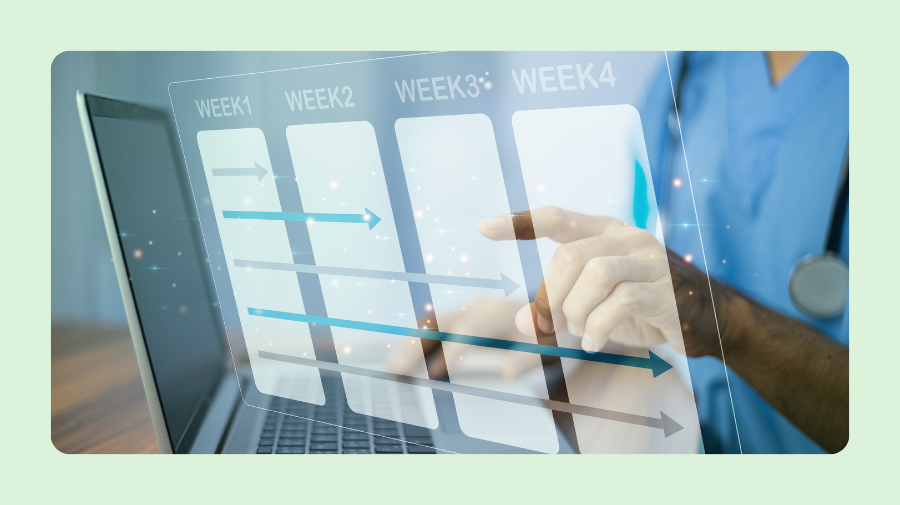
Healthcare is one of the most demanding industries in the world. Yet many facilities still rely on outdated scheduling methods that create chaos when staff call in sick or emergencies arise. If you've ever wondered why some hospitals seem to run like clockwork while others struggle with constant staffing crises, the answer often lies in their approach to real-time scheduling.
The Growing Need for Real-Time Healthcare Scheduling
Picture this: It's 6 AM on a Tuesday, and three nurses from the ICU have called in sick with the flu. In a traditional system, the charge nurse would spend the next hour frantically calling through a list of potential replacements, hoping someone could come in on short notice. Meanwhile, patient care suffers as the remaining staff scramble to cover extra assignments.
Now imagine a different scenario. The same three nurses call in sick, but within minutes, the hospital shift scheduling system automatically identifies qualified replacements and sends alerts to available staff. Within 15 minutes, the shifts are covered, and patient care continues without interruption. This isn't science fiction – it's the reality for healthcare facilities using modern real-time shift management technology.
Healthcare facilities face unique challenges that make traditional scheduling methods inadequate. Patient volumes fluctuate unpredictably, staff have varying skill levels and certifications, and regulatory requirements are strict. When you add in the human element of sick days, family emergencies, and burnout, it becomes clear why healthcare staff scheduling software has become essential rather than optional.

How Real-Time Scheduling Transforms Healthcare Operations
Instant Response to Staffing Emergencies
The most obvious benefit of real-time healthcare scheduling is the ability to respond instantly to unexpected changes. When a respiratory therapist calls in sick, the system should immediately identify who else is qualified and available to fill that specialized role. This rapid response capability prevents the domino effect that often occurs when one absence leads to unsafe staffing ratios across multiple units.
Fortunately, nurse scheduling software goes beyond simple replacements. These systems understand the complex web of healthcare roles, certifications, and patient acuity levels. They can automatically adjust assignments based on patient needs, ensuring that high-acuity patients always have appropriately skilled caregivers.
Enhanced Communication and Transparency
Real-time systems keep everyone in the loop through instant notifications and mobile access. Staff can check their schedules, request changes, and communicate availability from anywhere, creating a more engaged and informed workforce.
This transparency extends beyond individual schedules. Managers can gain real-time visibility into staffing levels across all departments, allowing them to spot potential problems before they become crises. When the emergency department expects a busy night, the system can help redistribute float pool nurses or call in additional staff proactively.
Intelligent Automation and Compliance
One of the biggest advantages of modern hospital shift tracking systems is their ability to automatically enforce compliance with labor laws, union contracts, and internal policies. These systems prevent accidental violations like excessive overtime, inadequate rest periods, or unsafe patient-to-nurse ratios that could lead to regulatory problems or compromised care.
The software continuously monitors work patterns and flags potential issues before they occur. If a nurse is approaching their maximum weekly hours, the system will automatically exclude them from additional shift opportunities, protecting both the employee and the organization from compliance violations.
Also Read: Common Challenges in Factory Operation Management (And How to Solve Them)
Data-Driven Decision Making
Real-time scheduling platforms collect vast amounts of data about staffing patterns, costs, and outcomes. This information helps healthcare leaders make informed decisions about hiring, training, and resource allocation. They can identify peak demand periods, track overtime trends, and optimize staffing levels to balance cost control with quality care.
Eliminating Administrative Burden
Traditional scheduling methods consume enormous amounts of administrative time. Managers often spend hours each week manually adjusting schedules, tracking down replacements, and updating multiple systems. Real-time shift management automates these routine tasks, freeing up leadership time for more strategic activities like staff development and quality improvement initiatives.
The reduction in administrative burden isn't just about efficiency – it's about reducing human error. Manual scheduling systems are prone to double-bookings, missed shifts, and communication failures. Automation eliminates these risks while providing complete audit trails for accountability and regulatory compliance.
Improving Work-Life Balance
Healthcare workers face significant stress and burnout, partly due to unpredictable and inflexible scheduling. Real-time systems empower staff by giving them more control over their work schedules. They can easily request time off, swap shifts with colleagues, or pick up additional hours when needed, all through user-friendly mobile applications.
This flexibility isn't just a nice-to-have perk – it's essential for retention. Healthcare facilities with more flexible scheduling report lower turnover rates, reduced recruitment costs, and higher employee satisfaction scores. When staff feel they have some control over their work-life balance, they're more likely to stay engaged and committed to their roles.
Also Read: Top Tools for Effective Manufacturing Staff Management
Ensuring Continuity of Care
Perhaps the most important benefit of effective hospital shift scheduling is its impact on patient care. Consistent staffing levels and smooth transitions between shifts directly translate to better patient outcomes. When handoffs are well-coordinated and staff aren't overwhelmed, the risk of medical errors decreases significantly.
Real-time scheduling also supports better care coordination by ensuring the right mix of skills and experience is available for different patient populations. Critical care units can maintain appropriate nurse-to-patient ratios, while specialized departments like oncology or pediatrics can ensure they have properly trained staff on every shift.

Reducing Wait Times and Improving Satisfaction
Efficient staffing leads to shorter wait times in emergency departments, faster response to patient calls, and more personalized attention. When healthcare facilities can quickly adapt to changing patient volumes, they provide more reliable and responsive care, leading to higher patient satisfaction scores and a better reputation in the community.
Also Read: A Beginner’s Guide to Production and Operations Management
Getting Staff Buy-In
The success of any real-time healthcare scheduling system depends heavily on staff adoption and engagement. The most effective implementations involve healthcare workers in the selection and design process, ensuring the system meets their real-world needs. Training and ongoing support are crucial for helping staff feel confident using new technology.
Integration with Existing Systems
Healthcare staff scheduling software should integrate seamlessly with existing HR systems, payroll platforms, and electronic health records. This integration eliminates duplicate data entry, reduces errors, and provides a comprehensive view of workforce management that supports strategic decision-making.
Conclusion
The shift from reactive to proactive staffing management represents a fundamental change in how healthcare operates. By embracing real-time scheduling solutions, facilities can create more resilient operations, happier staff, and ultimately, better outcomes for the patients they serve.


.svg)



.png)
.png)


.svg)
.svg)
.svg)